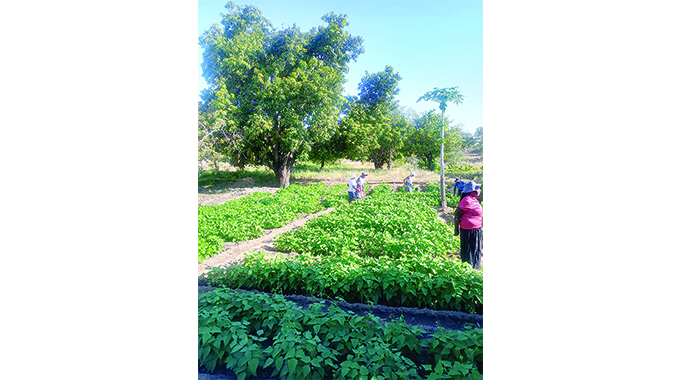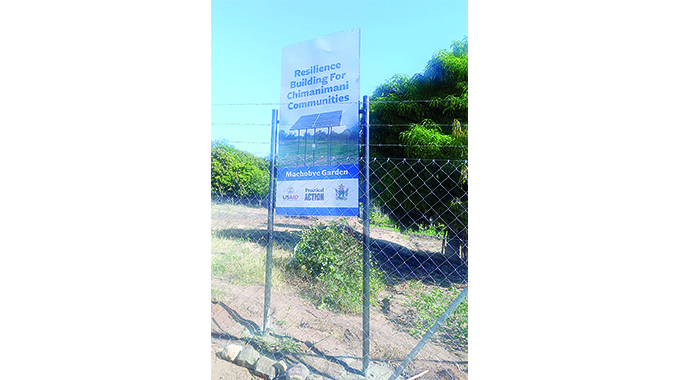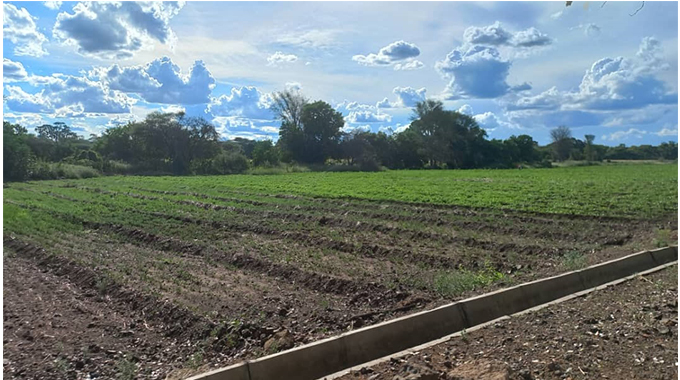Community harnesses hot spring to irrigate gardens

Sifelani Tsiko, [email protected]
Farmers at Chibuwe Village in Ward 5 of the Rupise area of Chimanimani District are retracing their ancestors’ footsteps and using water from Hotsprings – about 80km south of Mutare to grow vegetables and crops all year-round.
They are furrowing water from the geothermal hot spring into something much more than just a travel destination or resort for spiritual, medicinal and healing properties.
“This garden, we now call Muchobve here at Chibuwe Village, was always here even when I was born. For ages, my parents and my ancestors harnessed water from the Hotsprings for drinking and gardening,” said Ms Virginia Mawuwa, 65, of Chibuwe Village.

Women in one of their vegetable gardens
“We grew up growing crops here but the garden was dying because there was no fence to protect the area. Due to problems with cattle and goats, people had almost neglected gardening here. Lack of fencing materials and livestock problems forced most of us to stop gardening here.”
Massive deforestation in the area has led to the loss of trees needed for wood fencing. The absence of a garden was now affecting food and nutrition security for the villagers.
The introduction of a programme by Practical Action called the Resilience Building for Chimanimani Communities (RBCC) project, funded by the United States Agency for International Development (USAID) that aims to support affected communities to enhance their agricultural production, improve livelihoods through incentives for households working in gully reclamation and other community infrastructure, has spurred hope for villagers.
The programme also aims to support those participating in internal savings and lending schemes and to strengthen community response to climate hazards through early warning systems.
The project provided fencing materials worth US$6 000 and starter packs seed to help the farmers running the Muchobve Garden to grow vegetables and adapt to more challenging climate conditions.
“I’m so grateful for the support Practical Action, the Government and their partners have given us to improve our livelihoods here at Hotsprings,” said Ms Mawuwa.
“The installation of a fence around our garden has really changed everything for the better. The morale of farmers here is now good and everyone is optimistic about the future of gardening here.
“Water is abundant. Even when there is a drought, water still flows from the Hotsprings. We’re now going to grow crops whether there’s a drought or not. This is quite critical for our survival given the changing climatic patterns.”
The Muchobve Garden has 69 members with women making up the majority of the number.
The villagers grow beans, onions, tomatoes, sugar cane, green mealies and a range of vegetables for their own consumption and selling.
The farmers will get starter packs of seed for lettuce, onion, cabbage and butternut under the RBCC project.
“I’m so happy that we got a fence to protect our crops. Our vegetables are now secure and protected and we can now sleep knowing that no goat or cow will eat our crops,” said Ms Eunice Gudyanga, 50, of Chibuwe Village.
Said Ms Mercy Bvurere, (58): “I was really surprised by the gift, the fence we got. It didn’t take us a week to put the fence around our two-hectare garden. People were just happy about the donation.
“We’re now growing vegetables and the future is quite promising for us. Drought or no drought, we’re going to survive the changing climate.”
In addition, Muchobve Garden will get materials to build canals that will furrow water from the springs nearby to their garden.
“Things are looking bright for us and very soon we will get some money from selling vegetables. We should be able to pay fees and buy some items for ourselves,” said Mr Dakarai Mahlabana, 65, of Chibuwe.
“This is a step in the right direction. We need new canals and pipes to increase production here in our garden. We have lots of fruits here and we’re going to plant more.”
Practical Action evaluation and monitoring officer Mr Precious Moyo said the major focus of the programme was to build better resilience for vulnerable communities in dry and arid regions.
In addition, he said the focus will be on building a farming model that manages ecosystems well and uses natural resources sustainably, alongside strengthening early warning systems for weather-related threats, including floods and droughts.
“Under this project, we’re promoting agroecology. We’re encouraging the farmers to use organic fertilisers because it is sustainable and safe for the environment,” Mr Moyo said.
“Nothing goes to waste and no foreign materials come into their gardens. We’re training them in integrated pest management and agroecology so that they practice it and protect their environment. We want the farmers to go 100 percent organic.”
Mr Nhamo Kudana of Nemutenzi Village, who is the chairperson of Muchobvi Garden said before they got the fence, their crops were vandalised, stolen and eaten by domestic animals.
“Theft and vandalism of our garden was rampant. Our garden was open and unprotected. Last year, our bean crop was eaten by goats. The barbed wire we used was ineffective and we lost everything,” he said.
“Now things are better. The fence has secured our crops. We need canals to boost our water needs for our gardens.
“The canal is about 600m long and Practical Action is going to provide materials for the construction.
“We’re so happy about this. We have to grow what we eat and feed ourselves and the nation at large.”
The Rupise area of Chimanimani is particularly vulnerable to global warming and records show that rainfall has decreased significantly over the past decades leading to higher food shortages, food prices and drought-related livestock deaths.
The area is experiencing a decline in annual precipitation and an increase in mid-season dry spells, coupled with droughts and floods.
These changes in climate have reduced water availability and increased soil aridity, experts say, denting crop yields and making it tougher for smallholder farmers to survive.
The project by Practical Action to support the farmers, is an example of the kind of projects that will help the country to advance climate-smart agriculture.
There are many hot springs in the country that are mainly used for spiritual, medicinal and therapeutic purposes but these remain underexploited for irrigation purposes.

Villagers from Chimwara Village in Lupane District, Matabeleland North Province are also reported to be working on an irrigation scheme that taps water from a hot spring situated within a former safari farm in their area.
Experts say geothermal waters can prove to be an important source for mitigating the water crisis.
They also say that the use of geothermal hot spring water flow can be harnessed as an adaptation practice to improve subsistence crop production.
“We need to explore more ways that can contribute towards natural resource use and management as an adaptation measure to the problem of rainfall scarcity in subsistence production in areas such as Hotsprings,” said Mr Moyo.
“Farmers can run thriving community gardens in which subsistence crops are grown and maintained through a hot spring irrigation system.”

Irrigation scheme
And the Muchobve Garden, is one model that can be used to promote the use of irrigation systems downstream of the geothermal hot springs in which the water is furrowed to the garden to irrigate vegetables and fruits throughout the year.
Hot springs arise from discharge of hydrothermal groundwater at the earth’s surface and are often associated with pools of steaming hot water, discharging gas bubbles, sulphurous smells, mineral encrustations, and other components.
Geologists say hot springs are formed when water is heated by earth’s geothermal energy.
Most hot springs are formed when rain or groundwater seeps below the earth’s surface through cracks and faults. The groundwater collects in underground pools called aquifers or vents and eventually travels deeper toward the earth’s mantle where it is heated by magma.
Hot temperatures, coupled with high pressure deep in the earth, push hot water back up through cracks and faults forming a hot spring.









Comments